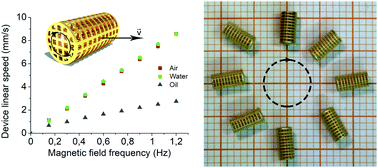当前位置:
X-MOL 学术
›
Mater. Horiz.
›
论文详情
Our official English website, www.x-mol.net, welcomes your
feedback! (Note: you will need to create a separate account there.)
Hard-magnetic cell microscaffolds from electroless coated 3D printed architectures†
Materials Horizons ( IF 12.2 ) Pub Date : 2018-05-18 00:00:00 , DOI: 10.1039/c8mh00206a Roberto Bernasconi 1, 2, 3, 4, 5 , Federico Cuneo 1, 2, 3, 4, 5 , Elena Carrara 1, 2, 3, 4, 5 , George Chatzipirpiridis 6, 7, 8, 9, 10 , Marcus Hoop 6, 7, 8, 9, 10 , Xiangzhong Chen 6, 7, 8, 9, 10 , Bradley J. Nelson 6, 7, 8, 9, 10 , Salvador Pané 6, 7, 8, 9, 10 , Caterina Credi 1, 2, 3, 4, 5 , Marinella Levi 1, 2, 3, 4, 5 , Luca Magagnin 1, 2, 3, 4, 5
Materials Horizons ( IF 12.2 ) Pub Date : 2018-05-18 00:00:00 , DOI: 10.1039/c8mh00206a Roberto Bernasconi 1, 2, 3, 4, 5 , Federico Cuneo 1, 2, 3, 4, 5 , Elena Carrara 1, 2, 3, 4, 5 , George Chatzipirpiridis 6, 7, 8, 9, 10 , Marcus Hoop 6, 7, 8, 9, 10 , Xiangzhong Chen 6, 7, 8, 9, 10 , Bradley J. Nelson 6, 7, 8, 9, 10 , Salvador Pané 6, 7, 8, 9, 10 , Caterina Credi 1, 2, 3, 4, 5 , Marinella Levi 1, 2, 3, 4, 5 , Luca Magagnin 1, 2, 3, 4, 5
Affiliation

|
The combination of 3D printing and wet metallization is a promising methodology for the manufacturing of functional microdevices able to carry out biomedical tasks in vivo. Following this approach, prototypical cell scaffolds are successfully manufactured in the present work. Functional layers are sequentially deposited employing electroless metallization on stereolitography 3D printed moveable structures. Final devices are characterized and magnetically actuated in a precise way using a novel rolling motion approach, which allows for a superior control over speed and position. From the living cells compatibility point of view, the scaffolds show good biocompatibility with fibroblasts after the application of a gold layer.
中文翻译:

化学镀3D打印架构的硬磁单元微支架†
3D打印和湿法金属化的结合是一种很有前景的方法,用于制造能够在体内进行生物医学任务的功能微装置。遵循这种方法,在目前的工作中成功地制造了典型的细胞支架。使用化学镀金属在立体光刻3D打印的可移动结构上顺序沉积功能层。使用新颖的滚动运动方法对最终设备进行表征并以精确的方式进行磁致动,从而可以对速度和位置进行出色的控制。从活细胞相容性的观点来看,在施加金层之后,支架与成纤维细胞显示出良好的生物相容性。
更新日期:2018-05-18
中文翻译:

化学镀3D打印架构的硬磁单元微支架†
3D打印和湿法金属化的结合是一种很有前景的方法,用于制造能够在体内进行生物医学任务的功能微装置。遵循这种方法,在目前的工作中成功地制造了典型的细胞支架。使用化学镀金属在立体光刻3D打印的可移动结构上顺序沉积功能层。使用新颖的滚动运动方法对最终设备进行表征并以精确的方式进行磁致动,从而可以对速度和位置进行出色的控制。从活细胞相容性的观点来看,在施加金层之后,支架与成纤维细胞显示出良好的生物相容性。











































 京公网安备 11010802027423号
京公网安备 11010802027423号